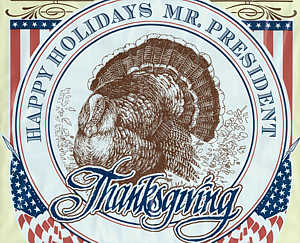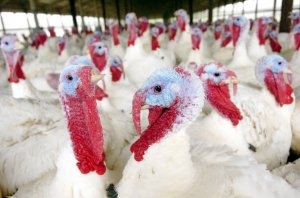 BY JONATHAN VALANIA Every Thanksgiving for the last 50 years, the Jaindl family turkey farm has been putting the bird on the dinner table at the White House. A Jaindl bird also goes to George Clooney, Michael Jordan, J. Lo, Dustin Hoffman, Tom Hanks and Arnold Schwarzenegger courtesy of Warner Bros. Studios, which has a standing annual order with Jaindl for 500 turkeys to be doled out to its sundry stars and VIPs. Meanwhile, some 350,000 families from Maine to Florida and as far west as the Mississippi — flyover country, as it were — will sit down today to give thanks for their painfully ordinary lives over a Jaindl turkey.
BY JONATHAN VALANIA Every Thanksgiving for the last 50 years, the Jaindl family turkey farm has been putting the bird on the dinner table at the White House. A Jaindl bird also goes to George Clooney, Michael Jordan, J. Lo, Dustin Hoffman, Tom Hanks and Arnold Schwarzenegger courtesy of Warner Bros. Studios, which has a standing annual order with Jaindl for 500 turkeys to be doled out to its sundry stars and VIPs. Meanwhile, some 350,000 families from Maine to Florida and as far west as the Mississippi — flyover country, as it were — will sit down today to give thanks for their painfully ordinary lives over a Jaindl turkey.
Located about an hour north of Philadelphia in the bucolic farmland flats of Orefield, the Jaindl turkey empire began as a modest 60-acre family farm back in 1937, yielding 2,000 turkeys annually. The farm has since grown to 500 acres, with an annual yield of nearly 1 million birds. Along the way, because the profit margins in agriculture are so narrow and subject to weather and disease, the family has diversified into banking and real estate holdings. The Jaindl family is now the largest landowner in the Lehigh Valley. The Jaindls are no-nonsense folks, so when I sat down recently with Fred Jaindl, the 71-year-old family patriarch, and son David, the 47-year-old who oversees the family’s financial, real estate and agricultural holdings, there were a couple of myths they wanted to dispel right away.
Myth No. 1: tryptophan, the sleep-inducing amino acid turkeys produce that, for a few hours on Thanksgiving Day, turns us into a nation comatose on the couch with our pants unbuttoned. When the subject is broached, father and son shrug. Fred, who’s been working with birds for going on three quarters of a century, says he’s never heard of it. “It’s an old wives’ tale,” says David, dismissively.
Myth No. 2: Turkeys are so dumb that during rain storms they will look up at the skies with their mouths open and drown to death. The Jaindls are passionate about this one; they consider it tantamount to slander. “Very far from the truth. Just ask any hunter,” says Fred. “They are hard to catch.” If nothing else, the Jaindls have respect for the  bird that’s brought them riches and power over the years.
bird that’s brought them riches and power over the years.
When I told these bird barons that we wanted to map the life of a turkey, from conception to the dining room table, we were met with narrow-eyed suspicion. They’ve had enough trouble with animal rights activists. No sir, they don’t plan to dole out any more ammo to some city slicker hack — and just what in hell is a blawg anyway?
Take it easy, Mr. Greenjeans, I said. We’re not looking to do some kind of PETA hatchet job. If you ask us, turkeys aren’t treated badly enough. They lay around all day watching soap operas and gorging themselves, mainlining tryptophan, shitting wherever they like, making no effort whatsoever to find gainful employment.
That didn’t go over too well. First of all, turns out no farmer likes to be called Mr. Greenjeans. Second of all, the Jaindls have built an empire on the backs of their fine feathered friends. And the least we could do is show a little respect. Fair enough. And so, with much prodding and cajoling, I managed to extract the story of the short happy life and painless death of a Jaindl turkey. It goes something like this:
There are female turkeys, called hens, and male turkeys, called toms. Each spring 23,000 turkey hens are artificially inseminated once a week for four months until the tom seed finds its purchase. It’s a fairly clinical procedure and, no, there’s no candlelit turkey love shack with a sunken tub and a heart-shaped bed where hens and toms consummate their love to the sultry sounds of Barry White.
The tom semen is extracted by placing a the donor bird on a “milking stool.” His feathers are “thinned back” and the tom is aroused. David Jaindl got a little bashful talking about this part of the procedure, so I thought better of asking if the toms were provided with some kind of turkey pornography to get them, you know, in the mood.
When a hen lays a fertilized egg, it’s placed in an incubator for 28 days. After the turkey chick hatches, it spends 10 days in the nursery. From there it’s moved to a pole barn outfitted with “brooding stoves” that simulate the warmth of a mother hen. For the next 24 weeks the turkeys mature in barns that hold up to 5,000 birds apiece.
Little is expected of them, other than to eat, drink and be merry until they achieve a mature weight of anywhere from 8 to 40 pounds.
The Jaindls take pride in the fact that they don’t use growth hormones, and antibiotics are administered only if  illness breaks out in one of the barns. They’ve even begun experimenting with a free-range division. All the Jaindl turkeys are bred to be “broad-breasted and short-legged.” “People generally don’t like long, lanky legs,” says David Jaindl.
illness breaks out in one of the barns. They’ve even begun experimenting with a free-range division. All the Jaindl turkeys are bred to be “broad-breasted and short-legged.” “People generally don’t like long, lanky legs,” says David Jaindl.
Come September, when most of the birds have achieved mature weight, they’re loaded onto coup trucks and driven to the processing plant, the afterlife for all domestic turkeys. A conveyor belt provides the final convenience in the turkeys’ lives, transporting them from the truck to the intake doors of the processing plant, “with a minimum amount of stress.” The birds are shackled and hung upside down on an assembly line. Then comes the stunning process, which David describes as “the humane way to go about it.” The birds are zapped unconscious with electricity, their necks are slashed and they’re sent on their way to turkey heaven.
When all the blood has drained out of the carcass, it proceeds along to the defeathering machines, where a series of “rubber picking fingers” pluck them bald. Then it’s on to the “eviscerating line” where the turkeys are split open and all the internal organs are removed. This part is still done by hand. From here, the birds pass through a series of chillers that bring the body temperature down to 40 degrees. Up next is the packaging line where inspectors grade them. If the carcass is intact with no bruises or skin tears, the bird is awarded Grade A status. (Grade B turkeys are pulled from the line and eventually sold to cutters, where they’ll become giblets and pot pies.)
The Grade A turkeys are outfitted with a cooking timer. After a few hours in the oven, when the temperature inside the turkey reaches 172 degrees, the little red thing pops up. It typically takes 13 to 16 minutes per pound to achieve that temperature. The turkeys are shrink-wrapped and passed through a steam chamber that ensures the packaging fits skin-tight. The turkeys are then put on a scale, and the weight is stamped on the side. The fresh turkeys go into refrigeration, where they literally chill out while waiting to be shipped to market. Their frozen brothers are put on ice. Some readers may be feeling a little sorry for these poor bastards. But look at this way: One of these lucky clucks is going to J. Lo’s house for Thanksgiving!
[This story originally appeared in the November 19, 2003 issue of PW]
